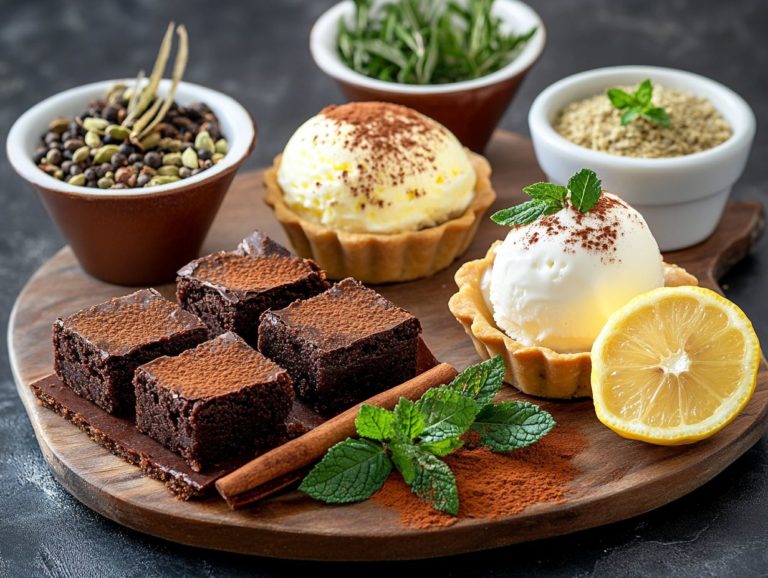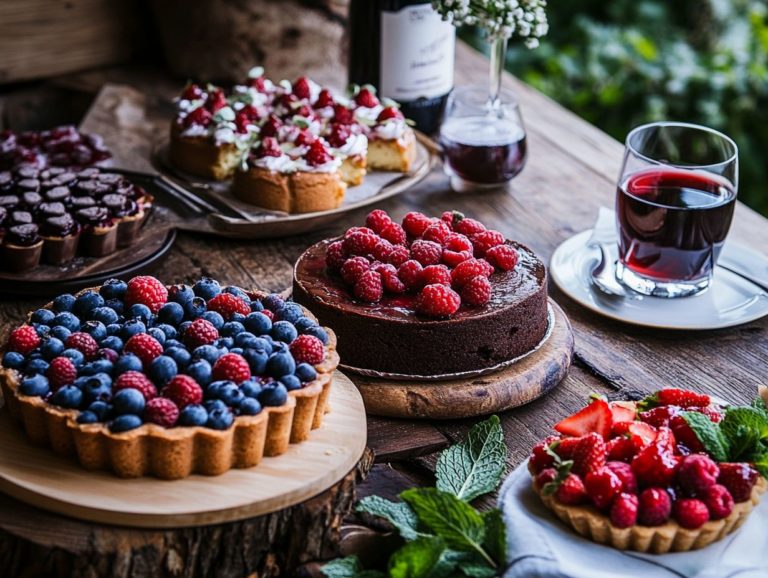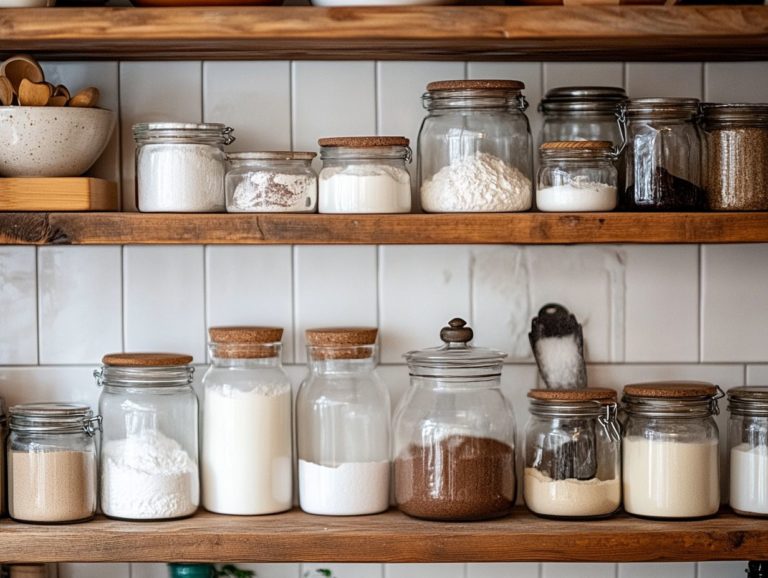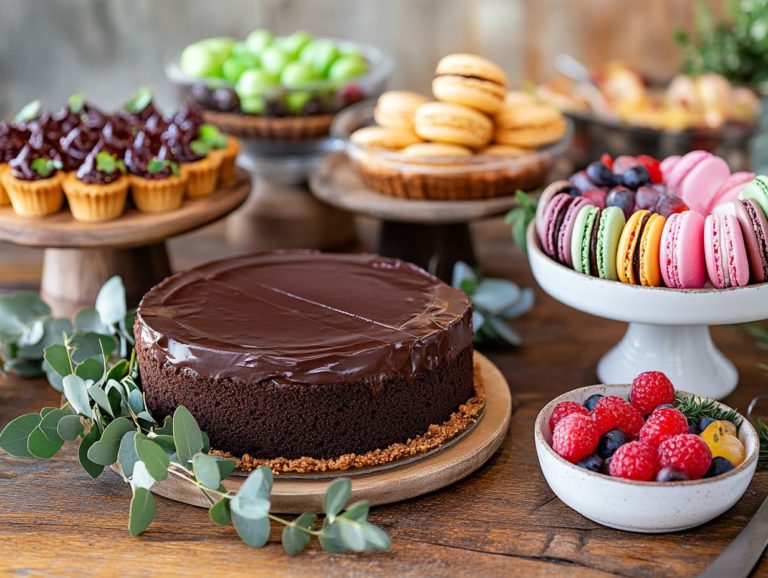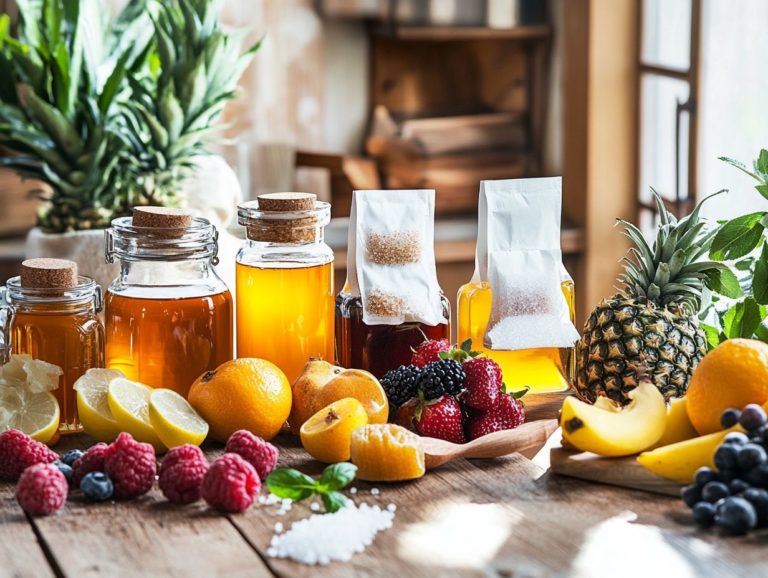What Is the Role of Eggs in Desserts?
Eggs are a versatile and indispensable ingredient in countless desserts, serving a pivotal role in elevating flavor, texture, and overall structure.
You ll delve into the nutritional value of eggs, uncovering their various functions in your favorite sweet creations and the advantages they bring to your recipes.
While exploring their benefits, you ll also consider potential risks, such as salmonella and allergies, and discover valuable tips for seamlessly incorporating eggs into your baking.
Uncover the secrets to making your desserts truly shine with the enchanting power of eggs, whether it’s for a chocolate sponge cake or Biscoff brownies!
Contents
- Key Takeaways:
- What are Eggs?
- What is the Nutritional Value of Eggs?
- How are Eggs Used in Desserts?
- What are the Benefits of Using Eggs in Desserts?
- Benefits of Using Eggs in Desserts
Key Takeaways:
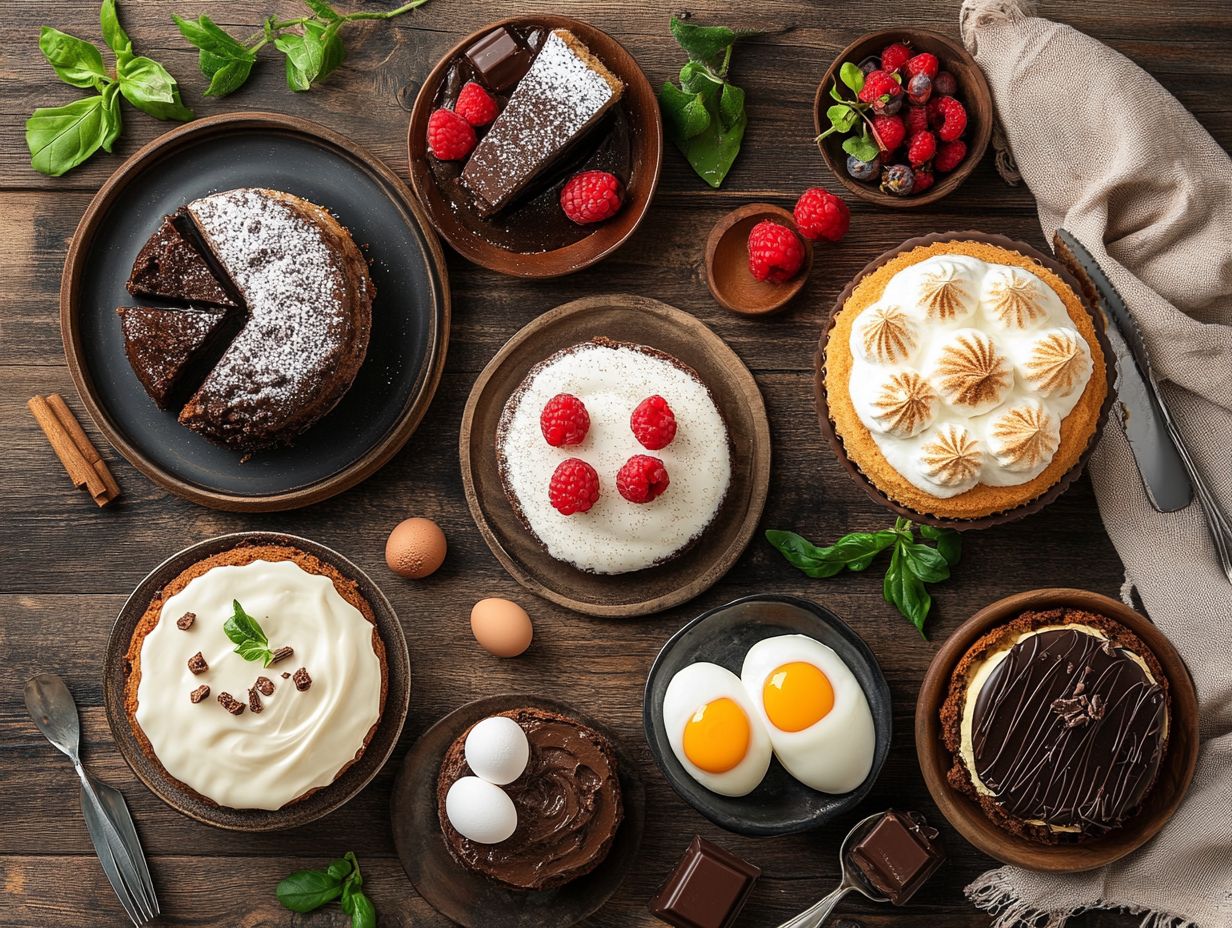
- Eggs are essential in your baking journey, providing both nutritional value and functional benefits, especially in recipes like muffins and bread.
- Using eggs in desserts can add moisture, enhance flavor, act as a binding agent, and contribute to leavening.
- To avoid potential risks and ensure optimal results, use fresh eggs, separate them properly, and follow recipe instructions.
What are Eggs?
Eggs are incredibly versatile ingredients that hold a vital place in cooking, especially in baking, where they enhance the structure, flavor, moisture, and texture of a wide array of baked goods, from cakes to Nutella babka.
Whether you re whipping up pastries, cakes, or even savory dishes like Hollandaise sauce, eggs are magic in the kitchen, acting as emulsifiers, binding agents, and leavening agents.
The two main components of the egg the egg whites and the yolk each offer distinct benefits. The egg whites deliver high-quality protein and can be whipped into a delightful foam for meringue.
Meanwhile, the yolk contributes richness and fat, elevating the overall flavor profile of your creations. Egg yolks also give a golden color to baked goods.
What is the Nutritional Value of Eggs?
Eggs are an exceptional addition to your diet, brimming with high-quality protein, essential fats, vitamins, and minerals that form the cornerstone of a balanced nutrition plan.
One large egg boasts around 6 grams of protein, making it a powerful ally for muscle repair and growth. The yolk, in particular, is a treasure trove of vitamins A, D, E, and B12, along with key minerals like selenium and choline.
This impressive nutritional profile not only bolsters your physical fitness but also supports weight management, as the protein content helps you feel full and keeps hunger at bay.
The healthy fats found in eggs are beneficial for heart health, providing you with a steady source of energy throughout the day.
The antioxidants lutein and zeaxanthin in the yolk are crucial for maintaining eye health, significantly lowering the risk of macular degeneration. By seamlessly incorporating eggs into your meals, you can effortlessly enhance your overall dietary balance and meet your daily nutrient needs with ease.
How are Eggs Used in Desserts?
Eggs serve as a cornerstone in a multitude of dessert recipes, elevating both the quality and enjoyment of your sweet creations.
In the art of baking, they play a crucial role, contributing structure and moisture to cakes, cookies, brownies, and muffins, while also functioning as binding and thickening agents in custards and puddings.
Their remarkable versatility shines through in elegant desserts like souffl s and meringues, where whipped egg whites transform into a light and airy texture that captivates the eye and delights the palate.
Additionally, egg wash is used to give a golden sheen to pastries.
What are the Different Types of Desserts that Use Eggs?
You ll discover a wide variety of desserts that feature eggs as a key ingredient, highlighting their versatility and vital role in the culinary world. Classic treats like cakes, cookies, meringues, and custards depend on the unique properties of eggs to create their distinct textures and flavors.
Pastries such as clairs and cream puffs also rely on eggs to achieve that light, flaky structure, underscoring their significance in dessert recipes. Eggs provide richness and moisture, making them essential in creations like sponge cakes, where whipped egg whites lend an airy texture while the yolks deepen the flavor.
Take tiramisu, for example; coffee-soaked ladyfingers are layered with a creamy mascarpone mixture enriched with eggs, adding both a luxurious mouthfeel and stability. The delicate balance of meringue exemplifies this further, whether enjoyed as pavlova or crafted into French macarons.
This showcases how the airy nature of whipped egg whites can produce both crisp exteriors and soft centers. For those seeking an egg substitute, aquafaba can mimic the properties of egg whites in these recipes. Ultimately, incorporating eggs into dessert recipes not only enhances functionality but also elevates flavor, making them a critical element of pastry and confectionery arts.
What are the Functions of Eggs in Desserts?
Eggs play a crucial role in desserts, with each function enhancing the final product s quality and characteristics. As a binding agent, they help ingredients stick together, ensuring a cohesive texture in your baked goods. They also act as emulsifiers, which help mix ingredients that usually don t blend well, like oil and water.
Fresh eggs are recommended for optimal results and food safety. Take cakes, for example. When you combine eggs with sugar, you create a foam that traps air, resulting in a light and airy structure once baked.
In custards and puddings, eggs serve as thickening agents, achieving that smooth and creamy consistency you crave. Variations like meringues highlight their ability to create volume and stability. In cookies, eggs not only bind the dry ingredients but also add moisture, preventing that dreaded dry or crumbly texture.
The versatility of eggs in dessert recipes truly underscores their importance in crafting the flavors and textures you desire.
What are the Benefits of Using Eggs in Desserts?
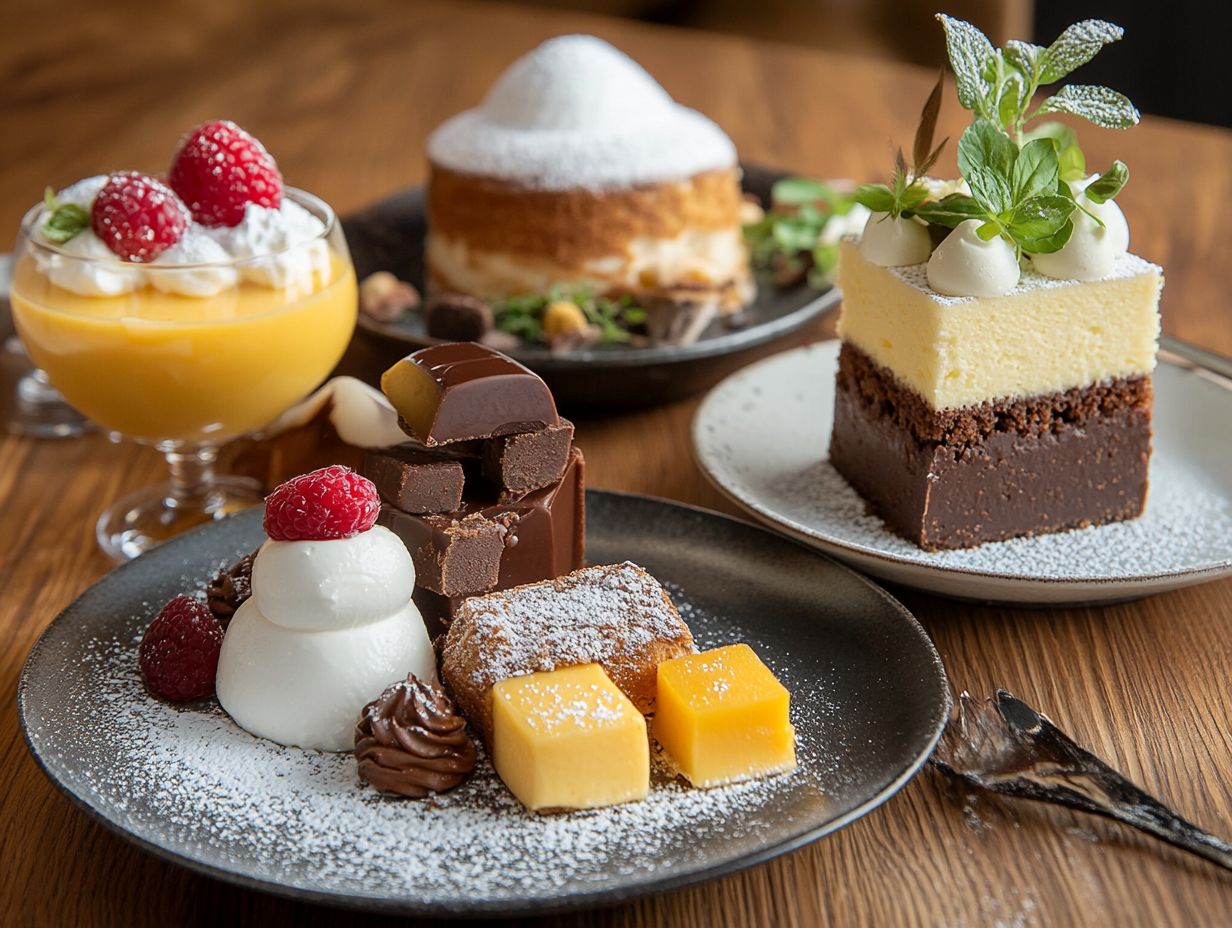
Incorporating eggs into your desserts presents numerous advantages, establishing them as a fundamental ingredient in the culinary realm. They significantly enhance moisture content, resulting in a tender and rich texture that elevates the quality of your cakes, cookies, and pastries, such as Biscoff brownies and Nutella babka.
Beyond their textural contributions, eggs impart a distinctive flavor profile. Their binding and leavening properties play a crucial role in achieving the ideal structure and lift in your baked creations.
1. Adds Moisture and Texture
One of the standout advantages of incorporating eggs in your baking is their remarkable ability to add moisture and enhance the texture of your creations. In recipes like brownies and cakes, the liquid from eggs interacts seamlessly with other ingredients, resulting in a soft, tender crumb that wards off dryness.
This moisture not only elevates the mouthfeel but also contributes to a more cohesive structure. Take a rich chocolate cake, for example; the eggs bind the ingredients together while imparting a delicate sheen to the surface, making it visually appealing.
For those seeking alternatives, egg substitutes like aquafaba can also provide moisture. In custards and puddings, the inclusion of eggs introduces a creamy consistency that significantly enhances the overall quality of the dessert.
The moisture from eggs is essential for achieving airy souffl s, where the fluffy texture relies heavily on those perfectly whipped egg whites. By grasping the vital role of moisture from eggs, you can dramatically elevate the final texture and taste of your delicious baked treats.
Ready to elevate your baking? Experiment with these egg-rich desserts today!
Benefits of Using Eggs in Desserts
2. Enhances Flavor
Eggs are crucial for making desserts rich and flavorful. They impart a richness that enhances the overall taste experience. In recipes like custards and chocolate sponge cakes, the fat content in the yolks not only enriches the flavor but also strikes a perfect balance with the sweetness of other ingredients.
This remarkable quality positions eggs as an essential component in an array of sweet treats. The yolks contribute significantly to creamy cheesecakes, helping to achieve a velvety texture while amplifying the tanginess of the cream cheese. Moreover, the yolks provide that characteristic richness in dishes like Hollandaise sauce.
In meringues, whipped egg whites do more than just create that delightful light and airy structure; they introduce a subtle sweetness that beautifully complements the dessert without overwhelming it. The versatility of eggs is particularly evident in luscious lemon curd, where their custard-like consistency harmonizes perfectly with the citrus tartness, making these desserts utterly irresistible.
3. Acts as a Binding Agent
Eggs are powerful binding agents in various dessert recipes, skillfully holding ingredients together and providing much-needed structure. This is especially crucial in creations like cookies and brownies, where the cohesion of ingredients is key to achieving that perfect cookie dough consistency.
As these delightful confections bake, the proteins in eggs coagulate, forming a stable matrix that keeps your cookies and brownies from crumbling. In cakes, eggs serve a dual purpose: they bind ingredients and help cakes rise, creating that light, airy texture that makes desserts so appealing. Proper egg storage is equally important to maintain their freshness and binding capabilities.
Consider sponge cakes, for example. Whipped egg whites infuse air and provide structure, while the yolks enrich the batter, highlighting the remarkable versatility of this humble ingredient. In custards, puddings, and pastry creams, eggs are critical for thickening, ensuring that each creamy bite holds together beautifully, delivering a luxurious experience with every spoonful. Eggs also contribute to the richness and texture of baked goods like chocolate sponge cake and Nutella babka.
4. Contributes to Leavening
Along with their binding properties, eggs are essential to the leavening process in many desserts, working their magic to create light and airy textures. When you whip egg whites, they trap air that expands during baking, contributing to the rise of souffl s and meringues, resulting in that fluffy, delicate quality you crave. The protein in egg whites helps stabilize the foam, while the fat in yolks adds moisture and richness.
But these leavening capabilities aren’t confined to just meringues; they also extend to cakes, pancakes, and muffins. How you incorporate and whip the eggs significantly impacts your final outcome. Take a classic angel food cake, for example: its airy structure relies heavily on those whipped egg whites, delivering that iconic height and softness. In pancakes, eggs create a tender crumb and balance the batter with their moisture content.
By understanding the pivotal role that eggs play as a binding agent, leavening agent, and emulsifier, you can master a variety of recipes and achieve that perfect, elevated texture in every delightful creation you whip up. Whether you re making brownies, bread, or savory dishes like Hollandaise sauce, the versatility of eggs is unmatched.
Are There Any Risks or Concerns When Using Eggs in Desserts?
While eggs offer a wealth of benefits in dessert recipes, don’t overlook the risks associated with using eggs they’re vital for safe baking. One of the foremost issues is the potential for salmonella contamination, which can arise if eggs are not handled or cooked with care. Improper egg storage and the use of cracked or dirty eggs can further increase this risk.
Moreover, it s crucial to remember that some individuals may have allergies to eggs. It’s important to contemplate alternatives and prioritize food safety precautions when preparing your desserts. Substitutes like silken tofu, aquafaba, and applesauce can be used to maintain the texture and binding properties necessary in recipes.
1. Risk of Salmonella Contamination
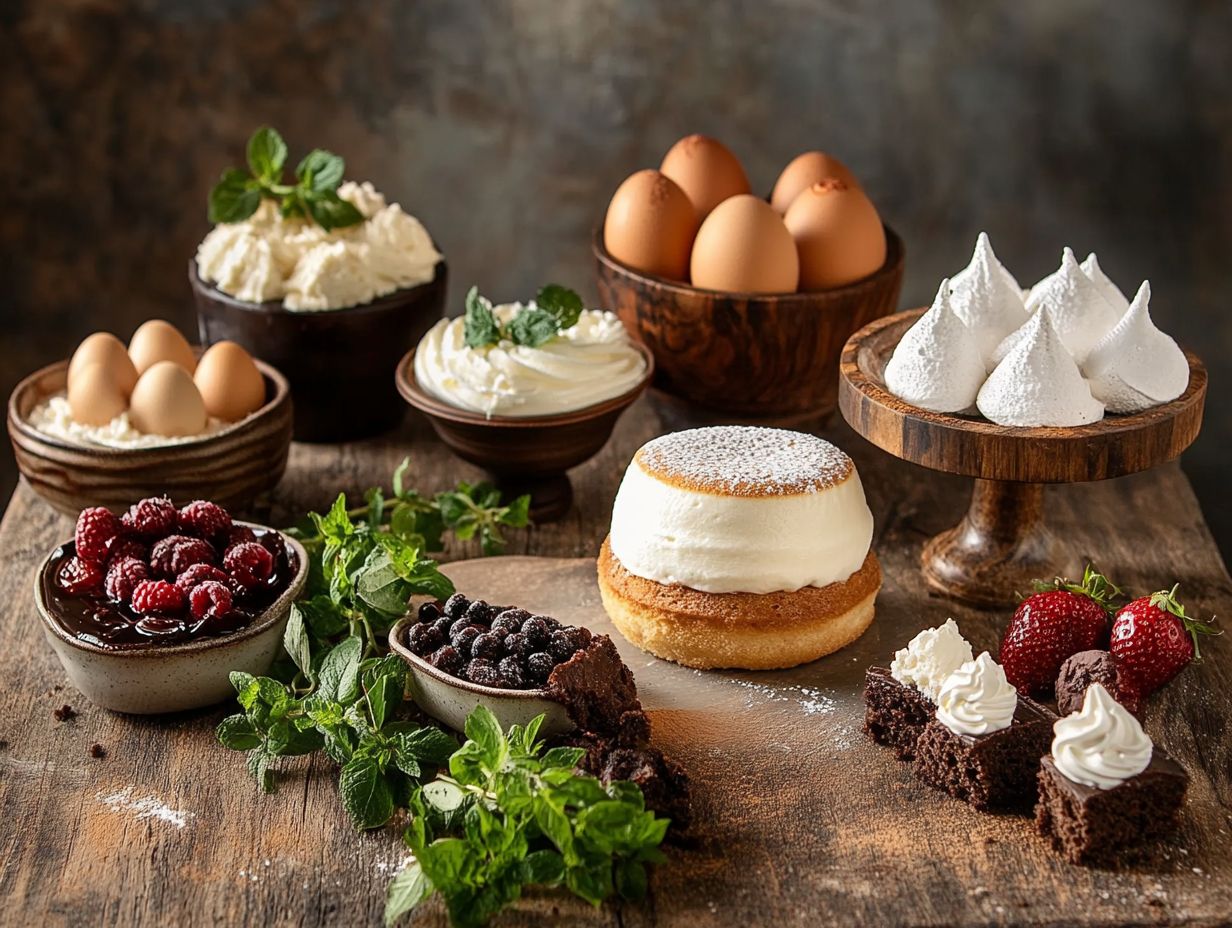
One of the most significant risks you face when consuming eggs is the potential for salmonella contamination a type of bacteria that can result in foodborne illness. To mitigate this risk, it s essential to purchase eggs from reputable sources and ensure they are stored and cooked properly.
Your journey toward prevention begins with safe egg storage practices. Keep eggs in their original carton in the coldest part of your refrigerator, ideally at or below 40 F. This simple step helps maintain their freshness and minimizes the risk of bacterial growth.
When preparing meals that involve eggs, be mindful of proper cooking temperatures; scrambled eggs and omelets should reach an internal temperature of 160 F. Practicing thorough hand washing before and after handling eggs is also crucial, as is avoiding cracked or dirty eggs.
By adhering to these guidelines, you can significantly reduce the likelihood of salmonella infection and enjoy your egg dishes with peace of mind.
2. Allergies
Egg allergies pose a significant concern for many individuals, as consuming eggs can trigger allergic reactions that range from mild discomfort to severe health risks. For those navigating this dietary challenge, it becomes essential to discover suitable egg substitutes in dessert recipes that preserve taste and texture while prioritizing health.
Individuals with egg allergies may experience a variety of symptoms, including hives, stomach cramps, or, in severe cases, anaphylaxis. Understanding the implications of living with an egg allergy is crucial, requiring meticulous ingredient selection and thoughtful meal planning.
Fortunately, a wealth of alternatives is available that can seamlessly replace eggs in your culinary creations. Options such as applesauce, mashed bananas, and silken tofu provide excellent substitutes, delivering moisture and binding properties essential for desserts. Additionally, aquafaba the liquid from canned chickpeas has gained acclaim for its remarkable ability to whip up like egg whites, making it an outstanding choice for crafting meringues and mousses.
By exploring these alternatives, you not only ensure the safety of your desserts but also unlock a realm of culinary creativity and flavor.
What are Some Tips for Using Eggs in Desserts?
To achieve outstanding results when incorporating eggs into your desserts, there are several essential tips that you should consider.
First and foremost, using fresh eggs can profoundly elevate the quality of your final creation, enhancing both its flavor and texture.
Furthermore, paying attention to proper egg storage and diligently following recipe instructions will help you harness the full potential of eggs in your baking, resulting in truly delightful desserts.
1. Use Fresh Eggs
Using fresh eggs is crucial for achieving the finest quality and flavor in your dessert recipes. Fresh eggs not only enhance taste but also contribute significantly to the overall texture and structure of your baked goods, making them a critical ingredient in your kitchen. Fresh eggs are nutrient-rich and provide both protein and fat, which are essential for various baking recipes.
When you embark on your baking journey, remember that the freshness of your eggs can dramatically affect the outcome of your treats, from cakes to cookies and custards. Fresh eggs impart a richness that elevates flavors and ensures the desired lightness in texture, which is essential for that perfect rise in souffl s or a delicate crumb in sponge cakes.
To determine the freshness of your eggs, you can perform the classic water test: simply place an egg in a bowl of water and observe its behavior. A fresh egg will sink to the bottom and lay flat, while older eggs will stand upright or float, signaling air seepage and reduced quality.
Embracing fresh eggs not only guarantees superior flavor and texture but also enhances the nutritional profile of your desserts, making them an excellent choice for the discerning, health-conscious baker.
2. Separate Eggs Properly
Properly separating eggs is an essential technique in baking, especially when your recipes call for both egg whites and yolks. By meticulously separating the two, you ensure that each component can perform at its best, such as whipping egg whites into a stable foam for meringues.
The process of egg separation is vital for achieving the desired textures and structures in a variety of baked goods. One effective method involves using the shell halves to gently transfer the yolk back and forth, allowing the whites to cascade into a separate bowl. This technique makes your desserts not just better, but absolutely delightful! It not only preserves the purity of each component but also reduces the risk of cross-contamination, which could compromise the integrity of delicate recipes like souffl s and cakes.
Proper separation is especially crucial for egg whites foam used in meringue and angel food cake batter. It’s also wise to crack eggs on a flat surface rather than against the edge of a bowl. This simple step helps prevent shell fragments from sneaking into your mix. Paying attention to these details can significantly elevate the quality of your final product.
3. Incorporate Eggs Gradually
Incorporating eggs gradually into your batter or mixtures is an important practice in baking that can significantly influence the outcome of your desserts. By adding eggs one at a time, you allow for better mixing, resulting in a smoother and more consistent texture. This is especially important in recipes like Biscoff Brownies and rich chocolate cake, where eggs contribute to a moist and tender crumb.
This technique not only enhances the even distribution of fats and liquids but also contributes to a light and airy structure in recipes like cakes and souffl s. For example, when you re preparing a rich chocolate cake, gradually incorporating the eggs can boost its moisture and tenderness, ensuring that your batter remains perfectly homogeneous and avoids curdling.
In recipes such as meringues or chiffon cakes, the gradual addition of eggs is crucial for achieving that coveted lift and stability, resulting in a delicate crumb. Ultimately, these thoughtful adjustments lead to baked goods that are not just visually stunning but also provide a delightful mouthfeel, making each bite an experience to truly savor.
4. Follow Recipe Instructions
Following recipe instructions to the letter is essential when you’re working with eggs, as the right techniques can profoundly impact the quality of your final product. By adhering to guidelines concerning egg incorporation, temperature, and timing, you set yourself up for success in dessert preparation.
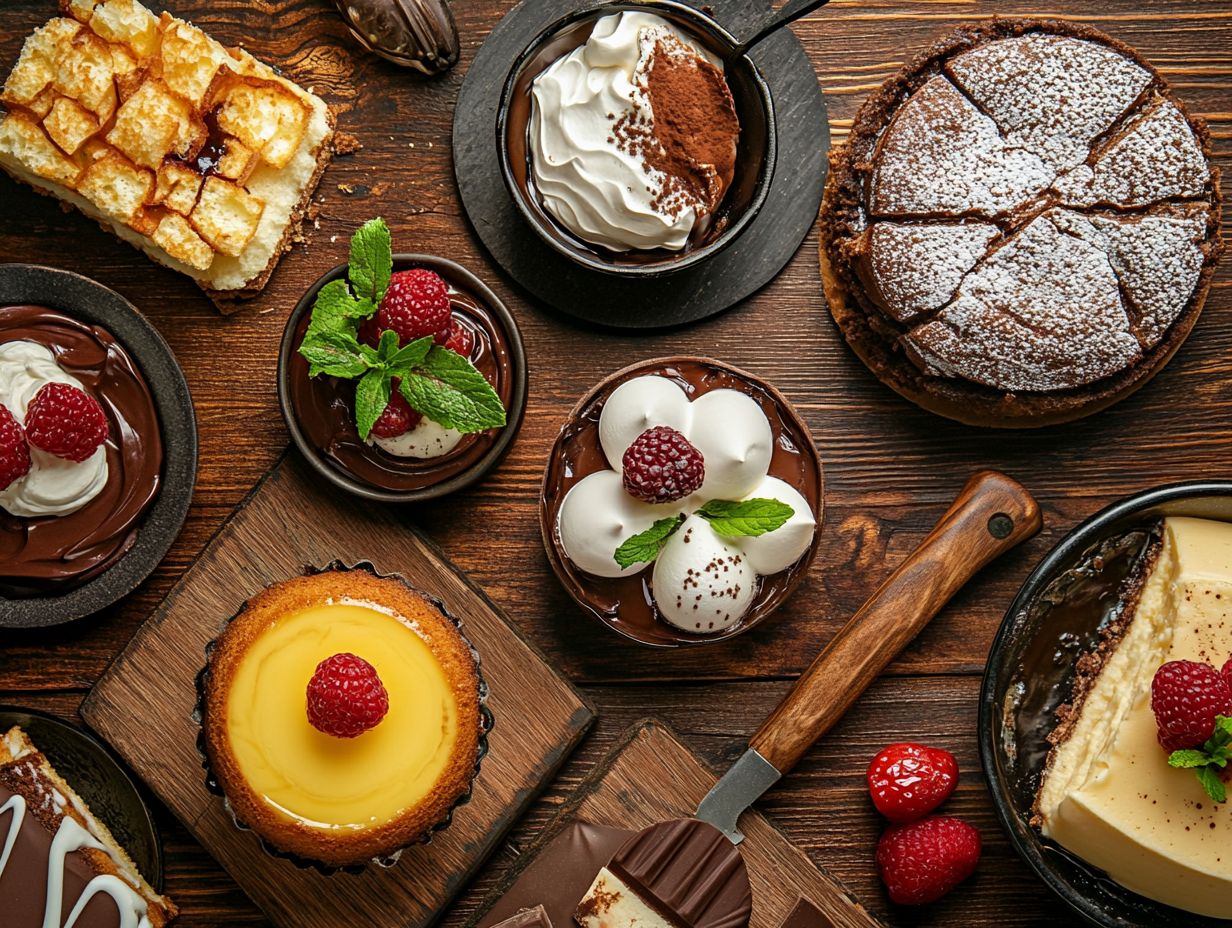
Eggs are the unsung heroes of baking, playing a crucial role in contributing structure, moisture, and flavor across a variety of dishes. For example, if you neglect to properly separate egg whites from yolks, you risk insufficient aeration in souffl s or meringues, leading to a dense texture instead of that coveted light and fluffy finish. Using eggs straight from the refrigerator can sabotage the emulsification required for certain batters. Using an egg wash can give pastries and bread a beautiful golden color.
By appreciating the importance of each step in the process, you can sidestep common pitfalls and achieve the perfect balance in your confections, elevating your baking to extraordinary new heights.
Frequently Asked Questions
What is the role of eggs in desserts?
Eggs play a crucial role in desserts as they contribute to the texture, flavor, and structure of many sweet treats, like cakes, cookies, and brownies.
How do eggs contribute to the texture of desserts and other baked goods?
Eggs add moisture and richness to desserts, creating a smooth and creamy texture. They also help with leavening, acting as a leavening agent and giving desserts a light and fluffy texture, especially in cakes and muffins.
What flavors and other qualities do eggs add to desserts?
Eggs have a unique taste that can enhance the overall flavor of desserts. They add depth and richness and can even add a slight savory note to sweeter desserts. Egg yolks, in particular, contribute significantly to the richness and golden color of dessert recipes like custards and chocolate sponge cake.
Here are some common questions about the role of eggs in your favorite desserts!
Try these tips out in your next baking project and share your delicious results with us!
Substituting Eggs in Dessert Recipes
Yes, there are several alternatives for eggs in desserts. Options include flax or chia eggs, applesauce, mashed bananas, and commercial egg replacers. Aquafaba is also a popular substitute for creating meringue.
However, these substitutes might not give you the same texture and flavor as real eggs, especially in recipes that need whipped egg whites or where eggs serve as a binding agent and emulsifier.
The Role of Eggs in Baking
Eggs act as a binding agent, holding together all the other ingredients in a dessert. They also help emulsify, creating a smooth and uniform mixture.
For example, in pastries like Nutella Babka or Biscoff Brownies, eggs are essential for achieving the right texture and structure.
Nutritional Benefits of Eggs in Desserts
Eggs are a good source of protein and contain important vitamins and minerals, making them a nutritious addition to desserts.
They also provide fat, especially from the egg yolks, contributing to the overall nutrient-rich profile of desserts.
Enjoy desserts in moderation to savor the flavors without the guilt! Be sure to store eggs properly and follow food safety guidelines.

